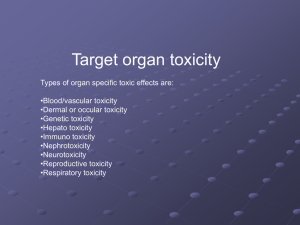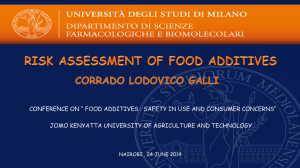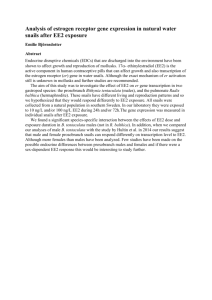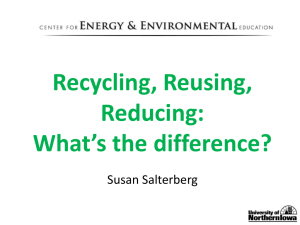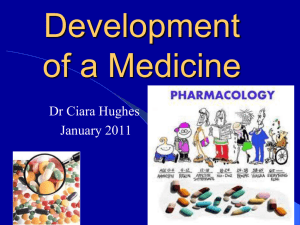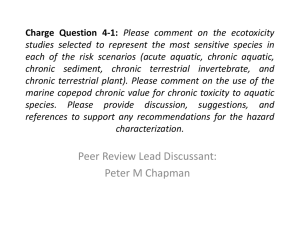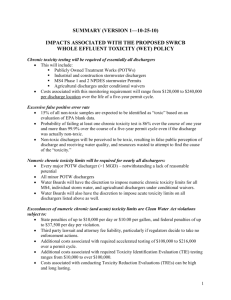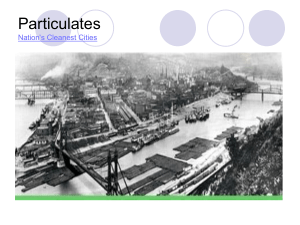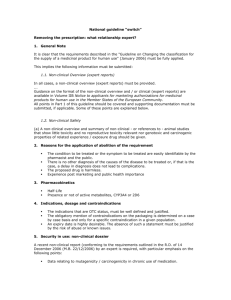Drug Metabolism and Toxicity
advertisement
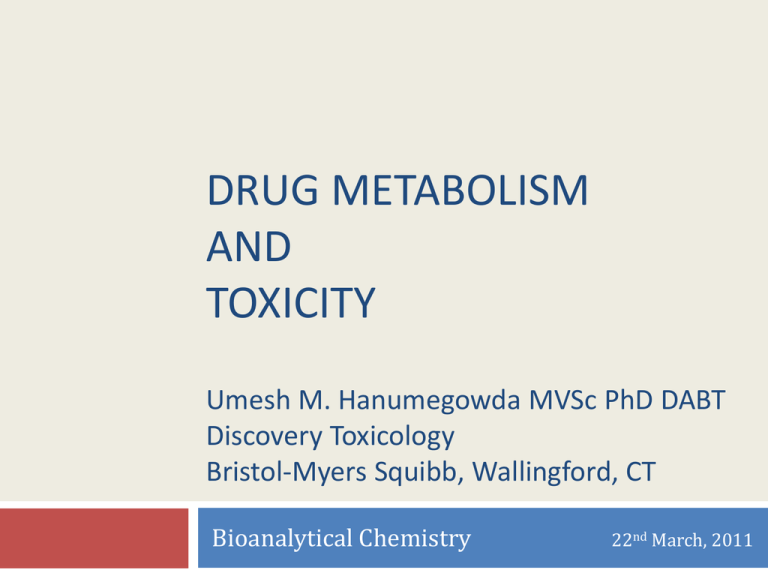
DRUG METABOLISM AND TOXICITY Umesh M. Hanumegowda MVSc PhD DABT Discovery Toxicology Bristol-Myers Squibb, Wallingford, CT Bioanalytical Chemistry 22nd March, 2011 2 DRUG METABOLISM Metabolic pathways Metabolizing enzymes & transporters Species differences and Polymorphisms Metabolic Pathways 3 Biotransformation: Conversion of xenobiotics to water-soluble compounds favoring elimination Phase I Hydrolysis, reduction, oxidation Ex., procaine, prontosil, alcohol Phase II Glucuronidation, sulfation, methylation, glutathione conjugation, acetylation Ex., acetaminophen, chloramphenicol, histamine, chlorobenzene, isoniazid Metabolizing Enzymes & Transporters 4 Microsomal Mitochondrial CYP, MAO, ALDH Cytosolic CYP, FMO, UGT, ALDH, Esterases, Epoxide hydrolases NAT, ADH, ALDH, AO, SULT, Esterases, Epoxide hydrolases, GST, Peroxidases Transporters MDR, MRP, BCRP, BSEP Species differences & Polymorphisms 5 Species differences Ex., Acetylation in dogs, glucuronidation in cats Ex., Aflatoxin tumorigenesis in rats but not in mice Genetic polymorphisms Leading to variability Ex., Slow metabolizers: CYP2D6 ~7% of Caucasians; CYP2C19 ~20% of Asians; FMO3 & fish odor syndrome Potential for toxicities Ex., Irinotecan in UGT1A1 deficient population 6 DRUG TOXICITY Classification General scheme Molecular mechanisms with selected examples Adaptation Classification 7 Exaggerated pharmacology Off-target pharmacology Ex., Halothane hepatitis Reactive metabolites Ex., QT prolongation with terfenadine Immunological Ex., Hypotension from beta-blockers Ex., Agranulocytosis with clozapine Idiosyncratic reactions Ex., Hepatotoxicity with carbamazepine General Scheme of Toxicity 8 DRUG Exaggerated on-target pharmacology Off-target pharmacology Trigger immune response Concurrent inflammation Exaggerated on-target pharmacology Off-target pharmacology Metabolite Reactive Adducted Protein Loss of function Enzyme inhibition Trigger immune response Deplete cell defense Trigger cell death pathway Non-reactive Altered DNA Carcinogenesis Teratogenesis Generation of ROS Deplete cell defense Cell death Carcinogenesis Teratogenesis TOX I C I TY From Drug Metabolism Handbook Concepts and Applications Molecular Mechanisms of Toxicity 9 Loss of function of cellular macromolecules Covalent modification Reactivity of intermediate Examples Tienilic acid hepatitis Inactivation of CYP2C9 Methapyrilene hepatotoxicity Binding to mitochondrial proteins NSAIDs liver/intestinal toxicities Ex., Zomiperac, diclofenac acyl glucuronides Molecular Mechanisms of Toxicity 10 Oxidative stress ROS (hydrogen peroxide, superoxide, hydroxyl) Overwhelm cellular defenses Enzymes (SOD, catalase) reduced glutathione, ascorbate Oxidative damage of DNA/protein/lipids Monocrotaline Normal liver PMN-induced HOCl modified proteins Molecular Mechanisms of Toxicity 11 Oxidative stress Examples Alcoholic liver disease ARV and atherosclerosis DES carcinogenesis Adenocarcinoma in offspring Thalidomide teratogenicity Radical-trapping agent prevent teratogenicity Molecular Mechanisms of Toxicity 12 Altered balance of cell survival and cell death p53-dependent apoptosis by disulfiram Neuronal loss in HIV dementia by NRTI Acetaminophen toxicity – protection by neutralization of Fas ligand/TNF Immune-mediated Primarily haptenation Ex., Autoantibodies to CYP2E1 in halothane hepatitis; Hypersenitivity reactions with abacavir Molecular Mechanisms of Toxicity 13 Concurrent inflammation Predispose to toxicity Idiosyncratic toxicity? Ex., acetaminophen, ranitidine, chlorpromazine hepatotoxicities precipitated by low-grade inflammation Kupffer cell depletion protects from toxicity Inflammatory mediators influence metabolism/toxicity acetaminophen Adaptation 14 Tachyphyllaxis Decreased response with subsequent doses Ex., antidepressants, antipsychotics Storage Phospholipidosis with CADs (Ex., Amiodarone) BMS-Y Alveolar Macrophage Adaptation 15 Enzyme induction Induction, Autoinduction Ex., Phenobarbital, Carbamazepine BMS-X Normal liver Relevance to carcinogenesis Hypertrophy 16 EXAMPLES OF METHODS TO EVALUATE METABOLISM-MEDIATED TOXICITY Metabolic fractions Time-dependent inhibition Metabolism competent cells Reactive metabolite trapping Metabolic Fractions 17 Liver S9 Standard for genotoxicity testing ex., Aroclor-induced rat liver S9 in Ames Microsomes Hepatic, intestinal, renal NADPH/ UDPGA fortified Supersomes Reaction phenotyping Time-dependent Inhibition 18 Microsomes NADPH supplemented Rate of disappearance of parent/substrate Ex., Verapamil – moderate time-dependent inhibitor of CYP3A4 (Midazolam as substrate) Verapamil 120 100 % Inhibition IC50, T0= 9.3 µM (± 0.7) IC50, T30= 0.7 µM (± 0.07) 80 60 40 20 0 0.01 0.1 1 10 [Inhibitor], µM 100 1000 Metabolism Competent Cells 19 Primary cells/cell lines Ex., hepatocytes, renal proximal tubule cells Cisplatin in HK2 Viability (% of control) Viability (% of control) Perhexiline in hepatocytes 100 75 50 25 0 0.1 1 10 100 1000 100 75 50 25 0 0.1 Concentration (M) Individual CYP expressing cells 10 100 Concentration (M) Limitations ex., Cisplatin in HK2 not predictive Engineered cells 1 1000 Trapping/ Covalent binding 20 Glutathione, N-acetyl-cysteine, phenyl-lysine Epoxides, nitrenium, acyl glucuronide etc., Potassium cyanide, sodium cyanide Aldehydes, iminium Microsomal protein covalent binding Thanks to……….. 21 Yang Wu Richard Diters John Megill Vinod Arora Tatyana Zvyaga Robert Roth Stephen Adams

